This summer, Roots & Culture hosted our first curatorial residency program, a three month stay for a jury- selected curator. We really lucked out with independent curator, Risa Puleo, who not only brought a thoughtful exhibition to Chicago, but also seemlessly embedded herself in our community, and happened to be quite an epicure.
Risa’s show was entitled “Cure (a rehearsal) for a Performance” and to quote her statement: “Care, rehearsal for a performance suggests a choreography of disability as a remedy for maneuvering through institutions that are disabling.” A show mediating the experiences of artists with disabilities within institutions.
The idea to collaborate on a dinner came about intuitively, Risa hoped to host a dinner party for new and old friends in Chicago as a send off at the end of her stay. Finding her to be a kindred spirit in the kitchen, I had been secretly hoping I might rope her into a cooking project. Very much in the spirit of the Piranha Club, we arrived at a theme and menu for the meal through conversation, in this case our mutual interests in healing, holistic, or homeopathic foods, dovetailing nicely with the curatorial premise of her show.
We mostly looked to time tested healing foods (or at least contemporary look-backs on older ways of eating): wild, foraged ingredients, fermented food, Pre-Columbian diet, and for one of my offerings, Chinese medicinal food.
Admittedly, my knowledge of Traditional Chinese Medicine is perfunctory. Mostly, I wander through the TCM shops in Chinatown wide-eyed, taking in the sights and smells of all the exotic dried flora and fauna. Some things I recognize from the Midwestern woods: reishi mushrooms, ginseng. And other stuff from culinary applications, like dried scallops. I delight in the jars of cordyceps fungus-infested caterpillars, but then get a bit queasy when I spy the deer tails. I am completely ignorant to the uses of any of these ingredients, but curious about their properties and sympathetic to their nature.
As someone who readily snarfs a veritable ark-ful of animal flesh, it may sound contrary of me to raise objection to some of the practices of obtaining ingredients for TCM, but draining the bile from living sun bears and slaughtering other endangered species to poach single body parts such as tiger penises, shark fins, and rhino horns is where I draw the line, millennia-old traditions or not. Are there calculable health benefits to the chemistry of these animal parts or is there a more animistic belief at play– consuming powerful animals will give power to the consumer. Certainly, men eat tiger penis so their member will be as virile as the tiger’s from which it was cut.
The black chicken, or silkie, certainly looks Satanic, all black-on-black, though it is a relatively common domestic breed of chicken, native to China. It’s meat is prized for its warming qualities in colder months and moreso for its beneficial properties for women’s reproductive health. I liked the poetry of flipping the oft-male-libido-fortifying focus (of meat) in TCM toward the feminine. Black chicken is typically made into a curative broth, often enhanced with other medicinal ingredients like ginseng or various funguses. A food consumed for healing rather than pleasure. I gathered up a variety of imported Chinese dried ingredients prized in TCM for my soup: white fungus (for liver protection and anti-inflammatory properties), goji berries (immune boosting, also good for liver function), and dried scallops (to tonify blood and add a fishy umami wallop to the broth). The soup was quite mild, slightly fishy, pleasant. I scooped a few forkfuls of my home made kimchi to perk mine up a bit.
Risa suggested a salad of dandelion and burdock, a dish for promoting liver health. Bitterness has fallen out of favor in the sweet-obsessed Western diet. Looking back to Asia, bitter flavors play an essential role in any meal, with a focus on balance of the five flavors (I’d love to lecture you about umami, the fifth flavor identified in Asian cuisines, but that will have to wait until another post). Even in European dining customs, you might begin or end a meal with a bitter alcoholic tonic (which I love). Bitter foods help your liver produce bile, which is essential for good digestive health, emulsifying fats (hmm, coincidence that my favorite foods are fatty cuts of meat and leafy greens). Dandelion greens are the grand daddy of bitterness and are nutrient-dense like trendy kale. I was stoked that I could forage dandelion and burdock in my backyard. In mid-August, the greens were bright green, fresh, and mostly tender. Unfortunately the burdock was dry, tough, and woody, so we ditched them for a simple salad.
Risa has been investigating the idea of a decolonized diet, meaning eating only pre-Columbian foods native to the Americas. This rules out such dominant ingredients as cow-based products, pork, wheat, and sugar. You can’t argue that most of the least healthy foods all contain some configuration of those ingredients. So a decolonized diet relies on new world vegetables: corn, squash, tomatoes, potatoes, beans with a light use of poultry (and I might argue insects). Dr. Luz Calvo and Dr. Catrióna Esquibel published a treatise/cookbook introducing this idea in 2015. To quote Dr. Calvo from an interview with Lucky Peach:
“We started researching Mexican ancestral foods, the foods that people in rural Mexico are eating, and finding that it’s really a plant-based diet. Meat is used only as a condiment. It’s not the cheese-laden food that you find at the typical Mexican restaurant here in the U.S.
We looked at particular foods that our grandparents talked about, nopales (prickly pear cacti), tlacoyos (corn cakes), and wild greens like verdolagas (purslane), and found that they all have anti-cancer properties. We came across studies that put indigenous groups on a standard American diet to see what happens to them, and then put people on an indigenous diet and see all their health measures improving.”
I cannot argue with these ideas. It reminds me a bit of Michael Pollan’s mantra “Eat food. Not too much. Mostly plants”. I do wonder for a second if this is about the healthful-ness of the pre-Columbian diet or sticking with a diet native to one’s ancestral homeland. What would that say about my Anglo-Saxon ass– hmm, a beer and pork diet, that doesn’t sound too far off!
So we rolled out chicken & bean tamales with a dash of molé. Risa found a recipe for pre-Columbian (no lard) tamales in my tattered old copy of Rick Bayless’ Mexican Kitchen. Remarkably, they cooked quickly in about 25 minutes (as opposed to 90+ minutes for fat and baking powder fortified masa). The results were surprising as well– supple, slightly dense masa, overall very satisfying. A classic three sisters rounded out the decolonized portion of our meal.
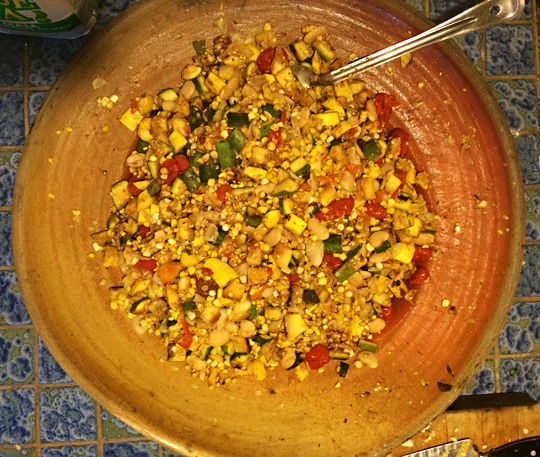
Risa’s impressive platter of three sisters– corn, zucchini, and fava beans with some tomatoes for color.
The questions I keep coming back to about these various approaches to healing foods is how locality factors in to the (actual or perceived) nutritiousness of a foodstuff. The TCM approach seems to favor rarified ingredients deemed powerful by their special-ness with around-the-globe origins. The silkie soup was nice, but it was really just a good gelatin-rich broth, which to me, is where its beneficial properties lie. I appreciated the ironic tension of serving a dish made from far-flung ingredients alongside such hyper-local things like greens from my backyard and counter-top fermented kimchi. The latter dishes, raw, vitamin-rich, and in the case of the fermented stuff, probiotic, to me, were undeniably the winners for healthiest foods on the table. And the idea of a native diet, a locality to one’s ancestry further complicates a question about the link of where food comes from and individual well being.
So how did the meal make us feel? Speaking for myself, I wasn’t particularly ailing that day, but the meal left me feeling energized and not overly stuffed. It digested well too. There were clearly many healthful ingredients on the table and I believe that food truly can be a kind of preventive medicine. For me, the best way to navigate my dietary needs is to listen to my body. When I am feeling unwell or run down, I like to eat food that makes me feel invigorated: unprocessed whole foods like raw vegetables, fruits high in vitamin C, broths, chiles, ginger, garlic… But health is a personal thing, so do what’s best for you. My ideas are not meant to be a prescription.
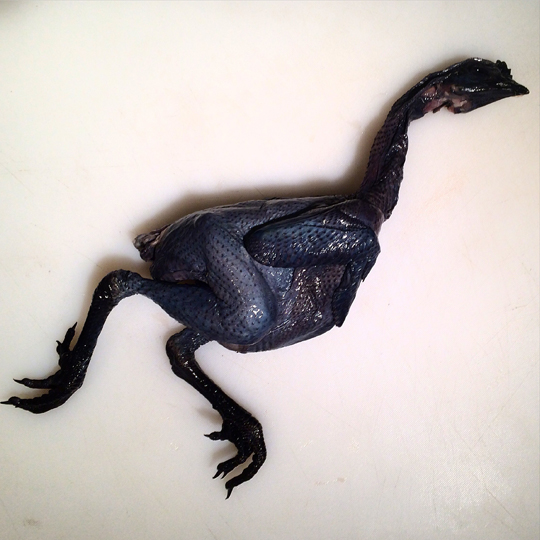
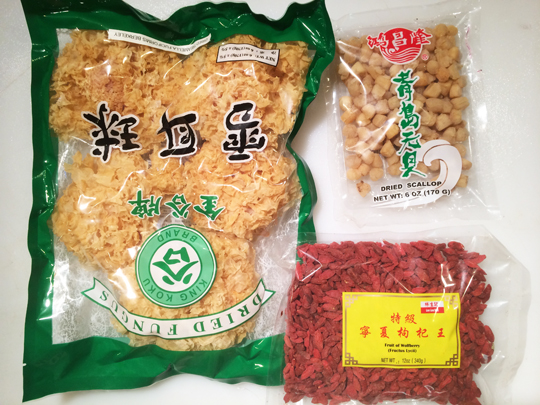
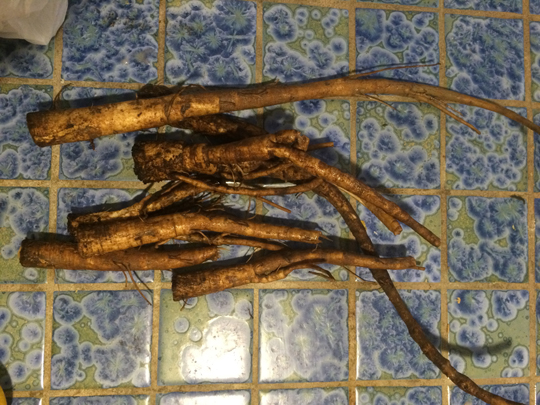
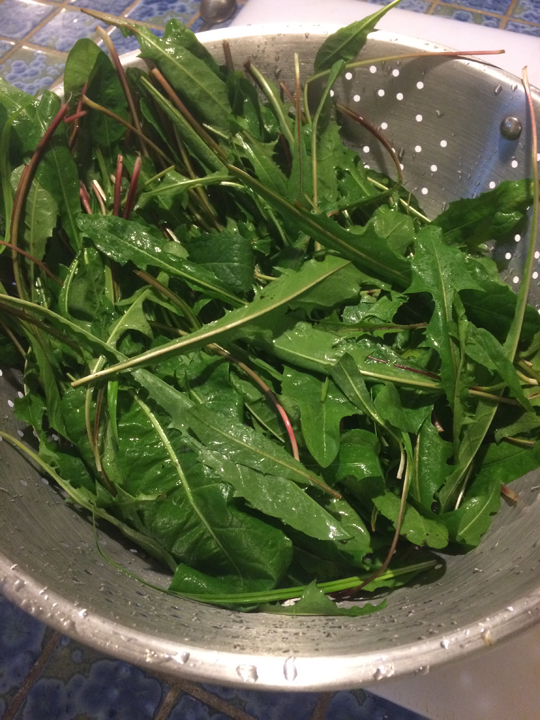
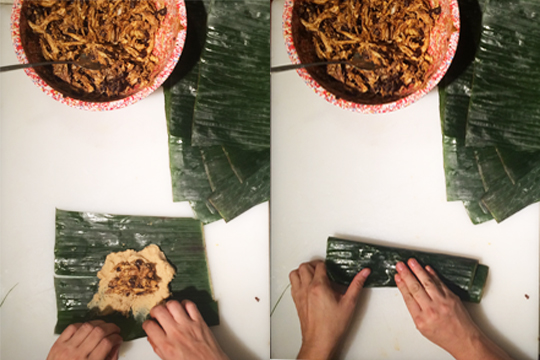
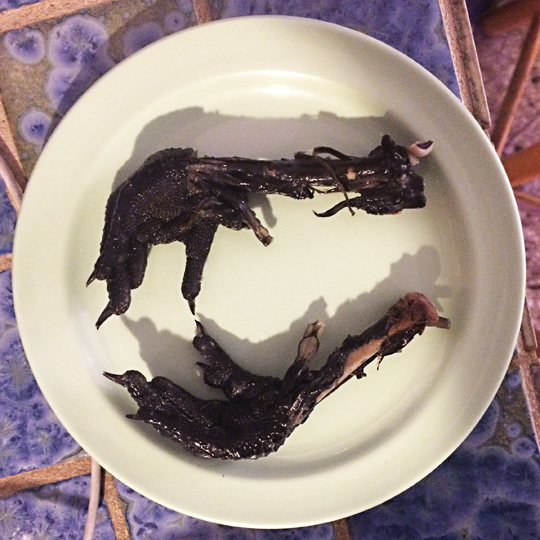
One Trackback
[…] spirits. In August I worked with Roots & Culture’s first curatorial resident, Risa Puleo on a healing themed dinner. I contributed a Traditional Chinese Medicine-inspired soup featuring dried Chinese cloud ear and […]